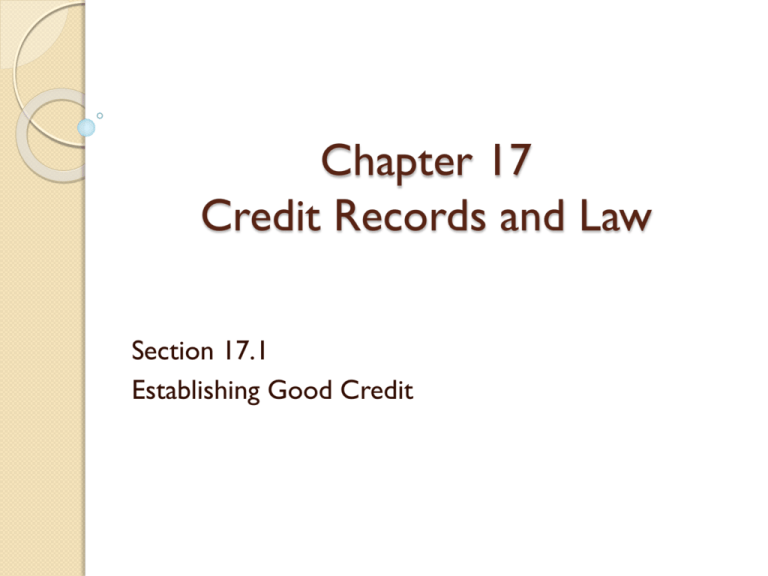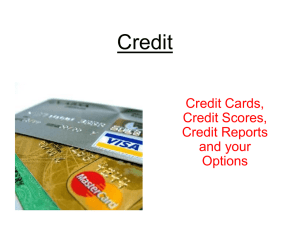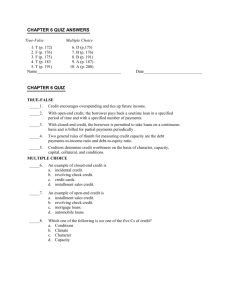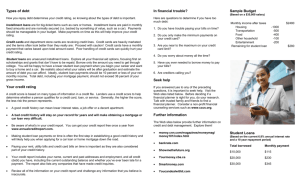Ch. 17 PowerPoint
advertisement

Chapter 17 Credit Records and Law Section 17.1 Establishing Good Credit Goals / “I can…” Describe what’s in a credit score Describe where you can find your credit score Describe ways to protect your credit identity in our digital world Pay bills on time? Pay debts according to loan agreement? credit history – complete record of your borrowing and repayment performance How much do you owe? How large are the payments you owe? credit bureau – company that gathers, stores, and sells credit information to business subscribers How Credit Bureau Processes Information Open a new credit account Credit bureau enters info in credit file – info is available to view Details about credit transactions are gathered Once a month, business transmits data about your activity to credit bureaus Customer uses credit and makes payments Business records the transactions Can be ordered online Can be by writing to a credit bureau credit report – written statement of a consumer’s credit history issued by a credit bureau to its business subscribers annualcreditreport.com **One free credit report per credit bureau per year** Checkpoint Question!! Getting Credit Information Credit bureaus get info from subscribers ◦ Subscribers pay a monthly fee ◦ Subscribers supply information about customers to the credit bureaus Credit bureaus get info from: ◦ Newspaper articles ◦ Public records Who has an Interest in Credit Information? Retail businesses Banks Employers Landlords Insurance Companies Creditworthiness Five Qualifications -5 C’s 1. Character 2. Capacity 3. Capital 4. Conditions 5. Collateral 1st Qualification of Credit-Character Will you Repay? Responsible attitude to go what you say you’ll do Pay on time Stability – may be used as a measure ◦ How often have you moved? ◦ More stable you are—better the credit risk 2nd Qualification of Credit-Capacity Can you Repay? Financial ability with present income Want to be sure your income is enough to cover the loan amount 3rd Qualification of Credit-Capital Is there protection if you don’t pay? Do you already owe a lot of debt? Is what you own greater than what you owe? Would your assets cover the payment of the debt? 4th Qualification of Credit-Conditions What might impact your ability to repay? Current economy How secure is your job? How’s the company you work for doing? Is there a demand for people in your field or occupation? 5th Qualification of Credit-Collateral What assets do you have? Do you have any thing of value? Possessions? Can possessions be sold easily? Quickly? Ways to Get Started with Credit Be sure you have a savings account Open a checking account when you obtain a job—record transactions/check balances/reconcile Establish credit by: ◦ Opening store credit account/card—Gap, Macy’s ◦ Obtaining a small loan from a bank or credit union ◦ Obtain one credit card—Visa or MasterCard **Be sure you pay on time and make all payments!!** credit rating – a measure of creditworthiness based on an analysis of the consumer’s financial history Credit Rating Systems Point System ◦ Credit bureau assigns points ◦ Points are based on certain factors Amount of debt Number of late payments Number of accounts Current employment Amount of Income Ratings—Excellent/Good/Fair/Poor ◦ Rates based on how reliably they pay back money borrowed ◦ Subscribers make own rating decisions FICO Score FICO stands for Fair Isaac and Company. Their scores are the credit scores most lenders use to determine credit risk. Each person has three FICO score, one for each of the three credit bureaus. As information changes, so does your score. FICO scores affect the loan terms, such as interest rate, that you will be offered. To calculate a FICO score, you must have at least one account open for at least six months. Your scores may be different at each of the credit bureaus because of varying information collected and slight differences in the way the rating system is applied. FICO Score Breakdown Payment History (35%) is rated based on how you pay your debts; the presence of bankruptcy, liens, or collections, and whether accounts are past due or paid as agreed. Amounts Owed (30%) is rated based on the amounts owed on accounts, amounts on specific types of accounts, lack of balances, and proportion of credit line used. Length of Credit History (15%) is rated based on the oldest account opened and the average age of all accounts. New Credit (10%) is rated based on the number of recently opened accounts and the number of recent credit inquiries. Types of Credit Used (10%) is rated based on the mix of credit accounts, such as credit cards, retail accounts, installment loans, mortgages, etc. Excellent Credit Rating 730+ Also called an A Rating Customers must pay bills before the due date Customer is well established Customer has used credit for many years Customer has paid off debts/loans early Good Credit Rating 670 - 730 Also called an B Rating Customers must pay bills on the due date or within the grace period (usually 10 days) Customer doesn’t miss any payments Fair Credit Rating 585 - 670 Earned by customer who usually pays with grace period Customer may occasionally take longer to pay Late charges are sometimes applied Usually don’t need a reminder Slow to pay—but pretty dependable Poor Credit Rating Below 585 Usually have payments that aren’t paid on a regular basis Miss monthly payments Need reminders about making payments May have not paid back a debt May have filed for bankruptcy May have been denied credit previously Credit Reports May be requested for lots of reasons Investigating credit applications Employment applications Insurance matters credit report video What’s in a Credit Report? 1. Summary Information ◦What to look for in report ◦Outlines +’s and –’s ◦Shows favorable items 2. Public Record Information ◦ Lawsuits, legal issues ◦ Marriage, divorce, adoption 3. Credit Information ◦List credit accounts ◦Gives details of the accounts payment status What’s in a Credit Report? 4. Account detail ◦Monthly balances ◦Lists credit limits 5. Request for credit history ◦ Lists businesses requests credit information from the file ◦ Examples are employers, creditors, insurance companies 6. Personal information ◦Name/previous names ◦Contact information/birthdate/SS# Reading a Credit Report Sample Credit Report Consumer Credit Protection Act Passed in 1968 Also called the Truth-inLending Law Requires lenders to fully inform consumers about all costs of a credit purchase Needs to be disclosed before the agreement is signed Lenders need to disclose: ◦ Finance charge ◦ APR – consumer can compare costs from other lenders Allows for a grace period of 3 business days to change your mind about an agreement Limits consumer’s liability to $50 after a credit card is reported lost or stolen No liability if card is reported lost or stolen and then someone else uses it Fair Credit Reporting Act Passed in 1970 A small fee may be Consumers have the right charged at other times to know what’s in their Have the right to have credit file inaccurate info Consumers have the right investigated, corrected or deleted to know who has seen their credit file You can comment on your credit file—give A listing of requests to see your side your credit in the last six months or two years – Your comments about depending on the information your credit file can be must be available for you added to your file Allowed to see your credit file at no charge within 30 days if you are denied credit Fair Credit Billing Act Passed in 1975 Creditors must resolve billing errors within a specified period of time Creditors need to have policies to correct errors in billing Consumers need to take responsibility to correct errors on credit card bills ◦ Letter explaining the problem ◦ Letter should include account number and information Complaints need to be in writing Complaints should be mailed within 60 days from receiving the statement Creditor must acknowledge your complaint within 30 days Creditor must correct or explain why bill is correct within 60 days Equal Credit Opportunity Act Passed in 1975 Designed to prevent discrimination Can’t be denied credit for the following reasons: ◦ Gender, martial status ◦ Religion, national origin, race, color, age— (minors may be exception) ◦ Receive unemployment, social security or retirement benefits Equal Credit Opportunity Act Creditors can’t ask certain questions – plans for having children, etc. Creditor can’t discourage you from applying for credit Creditors have to notify you of actions taken on credit application within 30 days of applying Denial of credit must be in writing Creditor needs to keep information about the denial You have the right to appeal a denial Requires that both husband and wife are responsible for debt Fair Debt Collection Practices Act Passed in 1978 Designed to eliminate abusive collection practices Regulated techniques used by debt collectors Debt collectors aren’t allowed to: ◦ Use threats, obscenities, false and misleading statements ◦ Intimidate consumers into paying Debt collectors can’t call at place of employment or in the middle of the night Debt collectors have to verify of the bill is accurate Consumers need to have a chance to clarify or dispute the bill Credit Cardholder’s Bill of Rights Passed in 2010 Protects consumers against unfair lending practices: ◦ Arbitrary rate hikes ◦ Double-cycle billing Consumers have right to review their rates and have them reduced Fair allocation of payments Payments must be made toward higher interest rates first No fees for paying bill early Consumers have to have enough time to pay their bill No tricks/gimmicks dealing with paying the bill by a certain time on a due date Protection for cardholders under age 21 Now it’s time to play a quick review game to see if you guys understood what we went over……………. Go to kahoot.it




